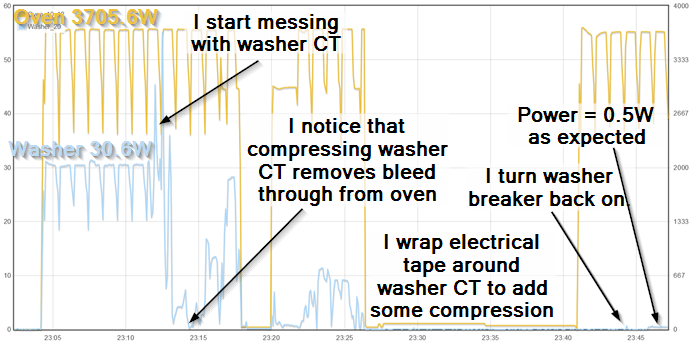I was seeing similar bleed-through on my IotaWatt I just installed. Among the other circuits, I was using an ECS1050 on Input8 to measure my 120V washing machine and an ECS16100 on Input6 to measure my 220V oven. Both of the hot leads went through the ECS16100 (entering the current transformer in opposite directions) to measure the total oven current. I was seeing around 31W reported on the washer (even with the washer’s breaker open) when the oven was drawing 3706W. The power waveform of the washer matched the oven except for having different a different amplitude. I noticed while looking at my IotaWatt’s status page that the 31W reported on the washer was reversed when the oven was on (no power should have been consumed by the washer at that time.)
My washer’s CT was in close proximity to the hot leads of the oven, so I thought I might be able to add some distance between them to reduce the bleed-through. Moving the washer’s CT didn’t help. Even though the washer’s CT (clamp-on type) was completely closed, I noticed that when I squeezed the top and bottom of the CT, the power reported on the washer would drop to zero. I ended up wrapping some electrical tape around the CT to create some compression on the clamp and now the washer reports 0.5W (as expected) when the oven is on.
My theory on CTs isn’t that good, so I’m not sure why compressing the CT’s clamp would have such a big effect. Maybe compressing the clamp decreased the electrical resistance between the split cores and reduced the effect of external magnetic fields generated from the oven wires? I tried it several times just to make sure that was what was reducing the bleed through. I haven’t taken a detailed look at my other CT’s, but the washer and oven combo was one that stood out. Graph of my troubleshooting shown below.
